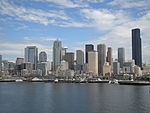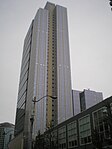1201 Third Avenue
1201 Third Avenue (formerly Washington Mutual Tower) is a 235.31-meter (772.0 ft), 55-story skyscraper in Downtown Seattle, in the U.S. state of Washington. It is the third-tallest building in the city, the eighth-tallest on the West Coast of the United States, and the 97th-tallest in the United States. Developed by Wright Runstad & Company, construction began in 1986 and finished in 1988. 1201 Third Avenue was designed by Kohn Pedersen Fox Associates and The McKinley Architects. The building was the world headquarters of the financial company Washington Mutual from the building's opening until 2006, when the company moved across the street to the WaMu Center (renamed the Russell Investments Center after the bank collapsed in 2008).
Excerpt from the Wikipedia article 1201 Third Avenue (License: CC BY-SA 3.0, Authors).1201 Third Avenue
3rd Avenue, Seattle First Hill
Geographical coordinates (GPS) Address External links Nearby Places Show on map
Geographical coordinates (GPS)
| Latitude | Longitude |
|---|---|
| N 47.6072 ° | E -122.3361 ° |
Address
1201 Third Avenue
3rd Avenue 1201
98101 Seattle, First Hill
Washington, United States
Open on Google Maps











